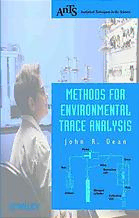Table Of ContentMETHODS FOR
ENVIRONMENTAL
TRACE ANALYSIS
Analytical Techniques in the Sciences (AnTS)
SeriesEditor: David J. Ando, Consultant, Dartford, Kent, UK
A series of open learning/distance learning books which covers all of the major
analyticaltechniquesandtheirapplicationinthemostimportantareasofphysical,
life and materials science.
TitlesAvailable in the Series
Analytical Instrumentation: Performance Characteristics and Quality
Graham Currell, University of the West of England, Bristol, UK
Fundamentals of Electroanalytical Chemistry
Paul M.S. Monk, Manchester Metropolitan University, Manchester, UK
Introduction to Environmental Analysis
Roger N. Reeve, University of Sunderland, UK
Polymer Analysis
Barbara H. Stuart, University of Technology, Sydney, Australia
Chemical Sensors and Biosensors
Brian R. Eggins, University of Ulster at Jordanstown, Northern Ireland, UK
Methods for Environmental Trace Analysis
John R. Dean, Northumbria University, Newcastle, UK
Forthcoming Titles
Analysis of Controlled Substances
Michael D. Cole, Anglia Polytechnic University, Cambridge, UK
Liquid Chromatography–Mass Spectrometry: An Introduction
Robert E. Ardrey, University of Huddersfield, Huddersfield, UK
METHODS FOR
ENVIRONMENTAL
TRACE ANALYSIS
John R. Dean
Northumbria University, Newcastle, UK
Copyright2003 JohnWiley&SonsLtd,TheAtrium,SouthernGate,Chichester,
WestSussexPO198SQ,England
Telephone(+44)1243779777
Email(forordersandcustomerserviceenquiries):[email protected]
VisitourHomePageonwww.wileyeurope.comorwww.wiley.com
AllRightsReserved.Nopartofthispublicationmaybereproduced,storedinaretrievalsystemor
transmittedinanyformorbyanymeans,electronic,mechanical,photocopying,recording,
scanningorotherwise,exceptunderthetermsoftheCopyright,DesignsandPatentsAct1988or
underthetermsofalicenceissuedbytheCopyrightLicensingAgencyLtd,90TottenhamCourt
Road,LondonW1T4LP,UK,withoutthepermissioninwritingofthePublisher.Requeststothe
PublishershouldbeaddressedtothePermissionsDepartment,JohnWiley&SonsLtd,The
Atrium,SouthernGate,Chichester,WestSussexPO198SQ,England,oremailedto
[email protected],orfaxedto(+44)1243770620.
Thispublicationisdesignedtoprovideaccurateandauthoritativeinformationinregardtothe
subjectmattercovered.ItissoldontheunderstandingthatthePublisherisnotengagedin
renderingprofessionalservices.Ifprofessionaladviceorotherexpertassistanceisrequired,the
servicesofacompetentprofessionalshouldbesought.
OtherWileyEditorialOffices
JohnWiley&SonsInc.,111RiverStreet,Hoboken,NJ07030,USA
Jossey-Bass,989MarketStreet,SanFrancisco,CA94103-1741,USA
Wiley-VCHVerlagGmbH,Boschstr.12,D-69469Weinheim,Germany
JohnWiley&SonsAustraliaLtd,33ParkRoad,Milton,Queensland4064,Australia
JohnWiley&Sons(Asia)PteLtd,2ClementiLoop#02-01,JinXingDistripark,Singapore129809
JohnWiley&SonsCanadaLtd,22WorcesterRoad,Etobicoke,Ontario,CanadaM9W1L1
Wileyalsopublishesitsbooksinavarietyofelectronicformats.Somecontentthatappears
inprintmaynotbeavailableinelectronicbooks.
LibraryofCongressCataloging-in-PublicationData
Dean,JohnR.
Methodsforenvironmentaltraceanalysis/JohnR.Dean.
p.cm.–(Analyticaltechniquesinthesciences)
Includesbibliographicalreferencesandindex.
ISBN0-470-84421-3(cloth:alk.paper)–ISBN0-470-84422-1(pbk.:alk.paper)
1.Pollutants–Analysis.2.Traceanalysis–Methodology.3.Environmental
chemistry–Methodology.4.Sampling.I.Title.II.Series.
TD193.D432003
628.5(cid:1)028(cid:1)7–dc21 2002028083
BritishLibraryCataloguinginPublicationData
AcataloguerecordforthisbookisavailablefromtheBritishLibrary
ISBN0-470-84421-3(Cloth)
ISBN0-470-84422-1(Paper)
Typesetin10/12ptTimesbyLaserwordsPrivateLimited,Chennai,India
PrintedandboundinGreatBritainbyAntonyRoweLtd,Chippenham,Wiltshire
Thisbookisprintedonacid-freepaperresponsiblymanufacturedfromsustainableforestry
inwhichatleasttwotreesareplantedforeachoneusedforpaperproduction.
To Lynne, Sam and Naomi
Contents
Series Preface xiii
Preface xv
Acronyms, Abbreviations and Symbols xix
AbouttheAuthorxxiii
1 Basic Laboratory Skills 1
1.1 Introduction 1
1.2 Safety Aspects 1
1.3 Recording of Practical Results 3
1.4 Units 3
1.5 Sample Handling: Liquids 5
1.6 Sample Handling: Solids 5
1.7 Preparing Solutions for Quantitative Work 6
1.8 Presentation of Data: Tables 6
1.9 Presentation of Data: Graphs 7
1.10 Calculations: Dilution Factors 9
Further Reading 11
2 Investigative Approach for Sample Preparation 13
2.1 Introduction 13
2.2 Quality Assurance 14
References 25
viii Methods for Environmental TraceAnalysis
3 Sampling 27
3.1 Introduction 27
3.2 Sampling Methods 29
3.3 Number of Samples 30
3.4 Sampling Soil and Sediment 31
3.5 Sampling Water 34
3.6 Sampling Air 37
References 37
4 Storage of Samples 39
4.1 Introduction 39
4.2 Methods 40
References 45
SAMPLE PREPARATION FOR INORGANIC ANALYSIS 47
5 Solids 49
5.1 Introduction 50
5.2 Decomposition Techniques 50
5.3 Dry Ashing 50
5.4 Acid Digestion (including the Use of Microwaves) 51
5.4.1 Microwave Digestion 55
5.4.2 Microwave Digestion Procedure 61
5.4.3 Fusion 64
5.5 Speciation Studies 65
5.6 Selected Examples of Metal Speciation 66
5.6.1 Mercury 66
5.6.2 Tin 69
5.6.3 Arsenic 70
5.6.4 Chromium 75
5.7 Selective Extraction Methods 76
5.7.1 Plant Uptake Studies 76
5.7.2 Soil Pollution Studies 76
5.7.3 Single Extraction Procedures 78
5.7.4 Sequential Extraction Procedure 83
5.7.5 Food Studies 88
5.8 Case Studies on Total and Selective Methods of Metal
Analysis 92
5.8.1 Example 5.1: Total Metal Analysis of Soil,
followed by Flame Atomic Absorption Spectroscopy 92
Contents ix
5.8.2 Example 5.2: Total Metal Analysis of Soil Using
X-Ray Fluorescence Spectroscopy – Comparison
with Acid Digestion (Method 3050B),
followed by Flame Atomic Absorption Spectroscopy 93
5.8.3 Example 5.3: Sequential Metal Analysis of Soils,
followed by Flame Atomic Absorption Spectroscopy 94
References 96
6 Liquids – Natural and Waste Waters 99
6.1 Introduction 99
6.2 Liquid–Liquid Extraction 100
6.3 Ion-Exchange 103
6.4 Co-Precipitation 104
References 105
SAMPLE PREPARATION FOR ORGANIC ANALYSIS 107
7 Solids 109
7.1 Introduction 109
7.2 Soxhlet Extraction 110
7.2.1 Example 7.1: Soxhlet Extraction of Polycyclic
Aromatic Hydrocarbons from Contaminated Soil 113
7.3 Shake-Flask Extraction 114
7.3.1 Example 7.2: Shake-Flask Extraction of Phenols
from Contaminated Soil 115
7.4 Ultrasonic Extraction 116
7.5 Supercritical Fluid Extraction 118
7.5.1 Instrumentation 120
7.5.2 Example 7.3: Supercritical Fluid Extraction
of Organochlorine Pesticides from Contaminated
Soil and ‘Celite’ 122
7.6 Microwave-Assisted Extraction 124
7.6.1 Instrumentation 124
7.6.2 Example 7.4: Atmospheric Microwave-Assisted
Extraction of Polycyclic Aromatic
Hydrocarbons from Contaminated Soil 126
7.6.3 Example 7.5: Pressurized Microwave-Assisted
Extraction of Polycyclic Aromatic
Hydrocarbons from Contaminated Soil 128
7.7 Pressurized Fluid Extraction 129
7.7.1 Instrumentation 130
x Methods for Environmental TraceAnalysis
7.7.2 Example 7.6: Pressurized Fluid Extraction
of DDT, DDD and DDE from Contaminated Soil 133
7.8MatrixSolid-PhaseDispersion134
7.8.1 Example 7.7: Matrix Solid-Phase Dispersion
of an Alcohol Ethoxylate (Lutensol, C13 and C15,
with an Average Ethoxy Chain of EO7), Spiked
onto an Homogenized Fish Tissue 135
References 139
8 Liquids 141
8.1 Liquid–Liquid Extraction 141
8.2 Solvent Extraction 142
8.2.1 Example 8.1: Liquid–Liquid Extraction of various
Polycyclic Aromatic Hydrocarbons from Water 145
8.3 Solid-Phase Extraction 147
8.3.1 Types of SPE Media 148
8.3.2 Cartridge or Disc Format 149
8.3.3 Method of SPE Operation 152
8.3.4 Solvent Selection 154
8.3.5 Factors Affecting SPE 155
8.3.6 Example 8.2: Solid-Phase Extraction of various
PhenolsfromWater157
8.4 Solid-Phase Microextraction 158
8.4.1 Experimental 159
8.4.2 Example 8.3: Solid-Phase Microextraction
ofBTEXfromWater162
References 164
9 Volatile Compounds 165
9.1 Introduction 165
9.2 Thermal Desorption 165
9.3 Purge-and-Trap 168
9.3.1 Example 9.1: Purge-and-Trap Extraction
of BTEX from Water 169
References 172
10 Pre-Concentration Using Solvent Evaporation 173
10.1 Introduction 173
10.2 Rotary Evaporation 174
10.3 Kuderna–Danish Evaporative Concentration 175

